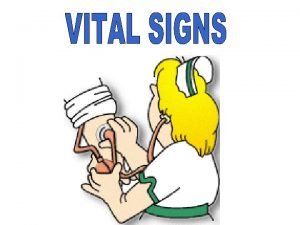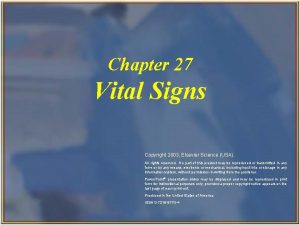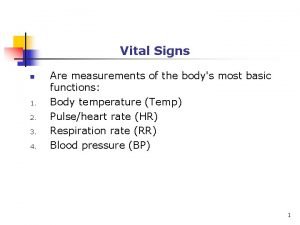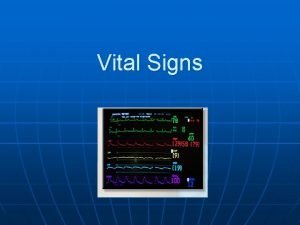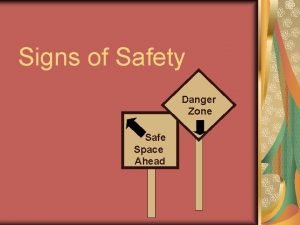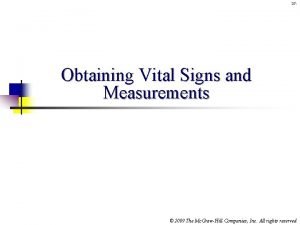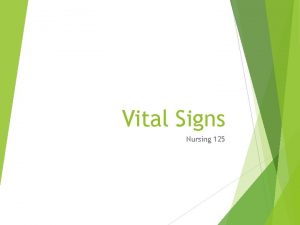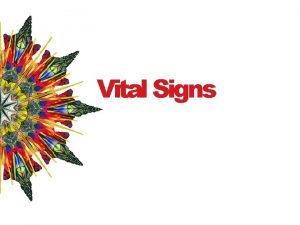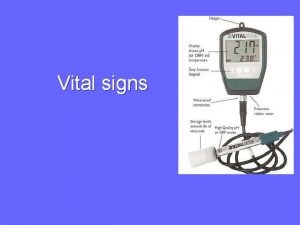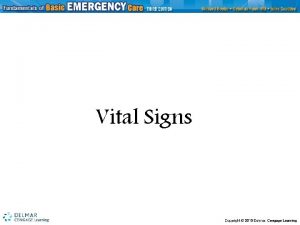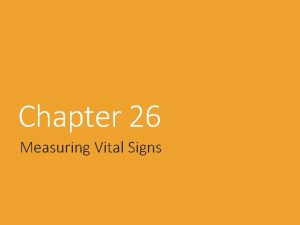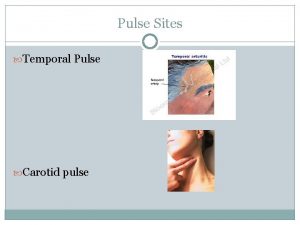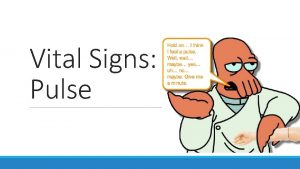How to Measure a Pulse Vital Signs in















- Slides: 15

How to Measure a Pulse Vital Signs in the Ambulatory Presentation SUB TITLE HERE title Setting: An Evidence-Based Cecelia L. Crawford Approach RN, MSN

Pulse Measurement – An Overview • Equipment for accurate pulse measurement § Watch or clock with second hand or digital second counter § Stethoscope for apical pulse (optional) § Pen or pencil § Flowsheet, chart, or medical record § Clean hands and fingers! • • Waited 5 minutes if patient was active Patient in a comfortable & relaxed position

Pulse – It’s All About The Numbers! Terminal Digit Preference • Some people may show a preference for certain numbers in pulse readings* § Zeros, even numbers, odd numbers • Be aware you might “like” some numbers more than others! (*Roubsanthisuk, W. , Wongsurin, U. , Saravich, S. , & Buranakitjaroen, P. , 2007)

Pulse Procedure 1. Wash hands & put on gloves, if appropriate 2. Provide privacy 3. Assist patient to a comfortable & relaxed position

Pulse Procedure - Radial 4. Do NOT use your thumb § Thumbs have a pulse, which can be mistaken for a patient’s pulse 5. Place fingertips of first 2 or middle 3 fingers over the radial pulse area § Thumb side of patient’s forearm at the wrist

Pulse Procedure - Brachial 4. Used for infants and small children 5. Place fingertips of first 2 or middle 3 fingers over the brachial pulse area § Inside of the elbow 6. Lightly press your fingertips on the pulse area

Pulse Procedure 7. Begin to count rate when pulse is felt regularly 8. Count for 60 sec 9. Count for 30 sec and multiply X 2 § Shorter time counts = inaccurate data

Pulse Procedure • If pulse irregular or skipping, count for 60 sec

Pulse Procedure – Apical (Optional) Listen to the heart with a stethoscope to count the pulse if: § Pulse is difficult to feel or count § Pulse is very fast or very slow

Pulse Procedure – Machine Taken • Automated BP machines can take pulse readings • Accurate with strong, normal pulses • Inaccurate with: § Very fast or very slow pulses § Weak, skipping or irregular pulses § Arm movement or agitation • When in doubt – count it yourself!

Pulse Procedure 10. Inform the RN or MD if pulse is: § Difficult to feel or count § Very fast or very slow § Irregular or skipping § An Apical pulse

Normal Pulse Rates Babies to age 1: Children ages 1 to 10: 100– 160 60– 140 Children age 10+ & Adults: Well-conditioned Athletes: 60– 100 40– 60 Mosby’s Critical Care Nursing Reference, 2002; Perry & Potter (2006)

Pulse Procedure 11. Discuss pulse rate with patient or parent 12. Remove gloves & wash hands

Pulse Procedure 13. Document the Results § Flowsheet, clinic record, or clinic chart 14. Communicate the Results § RN § MD

Pulse Measurement in the Clinic • YOU can make the difference: § Welcoming presence § Decrease any anxieties & fears § Reassure patients & family § Accurate vital signs
 Summary of vital signs
Summary of vital signs Sign shapes meaning
Sign shapes meaning Volúmenes pulmonares
Volúmenes pulmonares Apical radial pulse
Apical radial pulse Vital signs assignment
Vital signs assignment Esi level criteria
Esi level criteria Chapter 27 vital signs
Chapter 27 vital signs Chapter 14 basic nursing skills
Chapter 14 basic nursing skills Unit 14:1 measuring and recording vital signs
Unit 14:1 measuring and recording vital signs Radial pulse range
Radial pulse range Normal vital signs for all age groups
Normal vital signs for all age groups Fever pulse rate chart
Fever pulse rate chart Measuring and recording temperature
Measuring and recording temperature Normal bowel sound
Normal bowel sound Danger zone vital signs
Danger zone vital signs Chapter 36 body measurements and vital signs
Chapter 36 body measurements and vital signs



